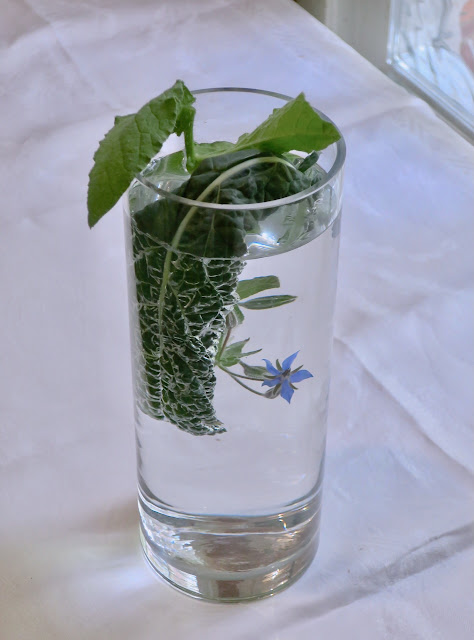This photo is the only one from that demonstration which is clear enough to show my intention at the time. Some of the materials I used came from my hosts vegetable garden. This is a single leaf of Kale and a stem of Borage placed under water in a glass cylinder. I wanted to show the silvery effect of the leaf's water repellant surface. The Borage flower arranged itself perfectly.
OUT AND ABOUT IKEBANA
INCORPORATING THE AREA AROUND THE VESSEL
VARIATION No. THREE
Two weeks ago I set my Melbourne class the exercise of making an ikebana "expressing a movement". Understandably, this led to the students focusing on the line in their ikebana. Line is an element of ikebana that the founder of the Sogetsu School, Sofu Teshigahara, spoke about in his "Kadensho". Among his observations, he spoke about the importance of the "...enhancement of line's beauty...". Ikebanists need to find the line in their materials and reveal it to the observer. Line is usually the clearest way of expressing movement.
Marisha chose to create a cascading line with this Devils Ivy Epipremnum aureum, from Mo'orea in the Society Islands. She added a line of flowering Wisteria and a similarly blue-coloured unnamed vine. Because of the length of the principal line, her basket is sitting on an inverted straight-sided ceramic vase.
Jacqueline chose the wandering movement of a tortuous willow which she emphasised with a purple ribbon. Two red carnations provided a small focal point in the space above the opening of the vessel.
Marcia created a swirling line below the water in a glass vase. Only two Dietes leaves were used so as not to clutter the vase. The single Ranunculus flower provides the focal point to the ikebana.
BASIC UPRIGHT IKEBANA for BEGINNERS
Tess also made this second rather bold, small ikebana in a box-shaped vessel with a corner opening. The botanical materials are a Yucca leaf, some small succulent rosettes and two dark green ivy leaves.
Ellie made an upright ikebana with two closely-spaced leaves and a mass made with two different kinds of small pink flowers.
Her second ikebana also featured pink flowers in an annulus-shaped vessel. A single line connected the two flower masses.
Her third work was dominated by a strong oblique line that came to a sharp bend and reflected back through a hole in the side of the triangular cross-sectioned vessel. The botanical materials are Bamboo and Jerusalem Sage Phlomis fruticosa.
Helen's exercise was to make a freestyle work. Her material was the unusual Salvia africana-lutea which has rust brown flowers. The irregular vessel by Graeme Wilkie proved challenging to achieve this strong horizontal design. The small bright yellow flower is Jerusalem Sage.
Maree's exercise was to make a "seasonal ikebana". She has used Japanese Maple for her branch material. The flowers are yellow Ranunculus and orange Clivia.
For my own ikebana this week I have created an ikebana arrangement from the basic curriculum.
VICTORIAN BRANCH ANNUAL EXHIBITON
This weekend the Victorian Branch of the Sogetsu School of Ikebana held its annual exhibition in the Linen Room of the Abbotsford Convent. The former convent was sold in 1975 and after a period as a campus of La Trobe University is now a community cultural and arts centre.
The exhibition featured 45 ikebana works by Branch member teachers and some of their students, as well as non-teaching members of the Branch. It was a big undertaking and the resulting exhibition was very pleasing. The layout of the exhibition grouped student work together with the intention of showing a clockwise progression around the space leading to more advanced ikebana by senior members.
An additional feature of the exhibition was the honouring of the bequest of ikebana vessels to the Victorian Branch from the estate of the late teacher, and former Director, Cherie Glaser. Practising teachers were invited to chose one of the vessels in which to set an ikebana arrangement. These ikebana works were grouped together in the centre of the room against Shoji screens as shown in the photo above.
This photo shows a group of ikebana where the exhibitors were using their own vessels.
Senior members were given the option of making two ikebana arrangements.
This is my second ikebana in a Japanese vessel that I had bought from Cherie some years earlier. I have used Bushy Yate Eucalyptus lehmannii with three stages of flower formation: operculum-covered buds, open flowers, and developing seed pods. The latter are against the front surface of the vessel and have yellow spikes.
My first ikebana was made in one of the bequeathed vessels, and was made by the Victorian ceramic artist John Stroomer. In his career of almost 50 years he has developed a great skill in creating crystalline glazes, in this case a very subtle pale blue. The ikebana I created used what must be the last of Elizabeth's budding Magnolia and a leafy branch of Oak. In the centre between the contrasting branches is a small mass of pale pink to white Helichrysum flowers.
I will eventually provide a link to further photos of the exhibition.
2nd October 2023





































